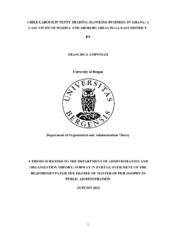Child Labour in Petty Trading (Hawking Business) in Ghana: A Case Study of the Madina and Abokobi areas in the Ga East District.
Master thesis
Permanent lenke
https://hdl.handle.net/1956/6403Utgivelsesdato
2012-12-03Metadata
Vis full innførselSamlinger
- Department of Government [457]
Sammendrag
This thesis discusses the conditions of child hawkers involved in child labour in the areas of Abokobi and Madina in the Ga East District as well as measures taken to assist child hawkers and the challenges, in the Ga East District. It employed three analytical frameworks which is the poverty model, norm or cultural model and the institutional model using Winter's integrated model of policy implementation. Three independent variables were derived from the three analytical model namely the socioeconomic model, cultural model and institutional model to explain the reasons for the influx of child hawkers in the areas and the challenges facing the implementation of child labour programs and laws. The study employed the mixed method research design by the use of case study, interview and the design of questionnaire. The total number of respondent were 103 made up of 50 parents, 50 child hawkers and 3 government officials involved in the implementation of child labour laws and programs. Purposive sampling method was used to select respondent and data collection tools such as face to face interview, direct observation and documentary sources have been employed. The result of the study found that poverty, low socioeconomic status of parents, gender and culture as well as the nature of economic activities within the areas have contributed to the influx of child labour in the Ga East District. The study also identified some effects of child labour on child hawkers in terms of education, health, physiology and psychology. The study also address some interventions adopted by the government to address the issue of child labour which are the introduction of the 1998 Children's Act, the FCUBE, among others and their challenges. The study finally discussed the main challenges facing the implementation of child labour programs and laws using Winter's integrated model of policy implementation. These are problem with coordination and cooperation among implementing agencies, ambiguity of roles and functions by some government ministries and departments, inadequate resource and target group behaviour.
